In 1983 the art historian Susan Beattie argued that Ford’s untimely death in 1901 ensured that his work happily predated the ‘unattractive Kiplingesque obsession with patriotism, health and “masculinity”’ that dominated much of British Edwardian culture. Beattie also claimed that Ford’s most explicitly imperial work – St George and the Dragon 1902 – ‘failed disastrously’.1 In 1999, by contrast, the conservator Pip Laurenson characterised The Singer as a ‘fascinating document about the Victorian perception of other cultures subsumed under the notion of “Orientalism”’.2 What, therefore, were the imperial implications of Ford’s neo-Egyptian figures in the context of British involvement in Africa in the second half of the nineteenth century, and in relation to ideas of race current at the time?

Fig.1
Ralph Robinson
Edward Onslow Ford in his Studio 1892
© National Portrait Gallery, London
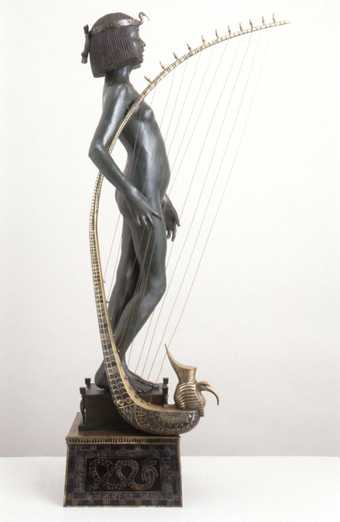
Fig.2
Edward Onslow Ford
The Singer exhibited 1889 (side view)
Around 1890 acclaimed late-Victorian photographer Ralph Robinson was at work on a series of studio portraits of some of the most eminent Victorian artists, including Edward Onslow Ford (fig.1). In Robinson’s photograph, taken in c.1890–1, Ford is juxtaposed with The Singer (top-left) and with the model (middle-right) for Ford’s c.1887–9 Khartoum and Chatham monuments to the British army officer and imperial administrator, General Charles George Gordon. Capturing the General in ‘oriental dress on a fully caparisoned camel’, the monument commemorated the widely-reported and much-mourned death of Gordon in the Sudan in 1885.3
The positioning of these two works at the same height in Ford’s studio serves as a reminder of the sculptor’s sustained professional investment in, and profit from British imperial markets and colonial conflict. With this in mind, it might be conceivable that The Singer and Applause, as representations of Egypt – a British imperial conquest of comparative success from the perspective of the late 1880s – sought to counterbalance the tragedy articulated by Ford’s General Gordon, particularly since Egypt and the Sudan were as adjacent on the imperial map as The Singer and General Gordon are in Robinson’s photograph of Ford’s studio.
From the mid-century onwards, while France remained a key presence in northern and west Africa, Britain was, according to the art historian G. Alex Bremner, ‘seriously involved in developing the agricultural and industrial capabilities of Africa’, and at the ‘forefront of missionary activity’ in the region.4 According to the historian Maya Jasanoff, between 1789 and 1850 Britain published ‘more than twice as many travel books on Egypt’ than France,5 and according to Bremner, by 1849 Egypt’s exports to Britain were eight times greater than those to France, Egypt’s British imports were six times higher, and by the 1860s, Britain was largely funding the development of the Suez Canal, which had finally opened in 1869, and whose majority ownership Britain had gained by the 1870s. In the same period Britain had also become Egypt’s ‘most important foreign developer and trading partner’ because of the export of Egyptian cotton to Britain’s textile manufacturing industry. In 1882, just seven years before Ford first exhibited The Singer, Britain effectively occupied Egypt, controlling the country until 1936, with Egypt becoming a British protectorate in 1914.6
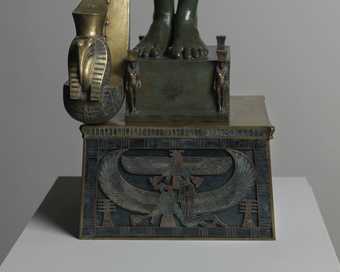
Fig.3
Edward Onslow Ford
The Singer (detail)
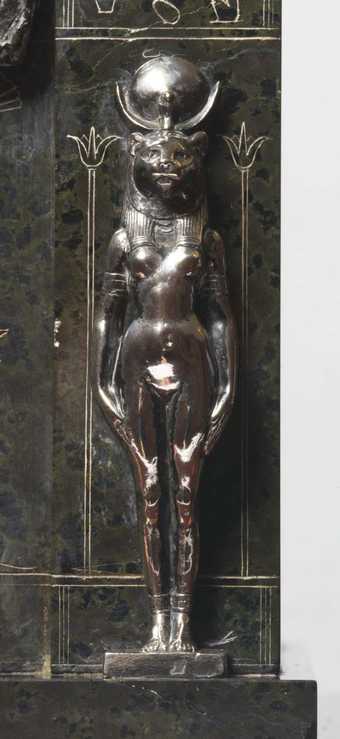
Fig.4
Edward Onslow Ford
Applause 1893 (detail of statuette of Bashtet on back of plinth)
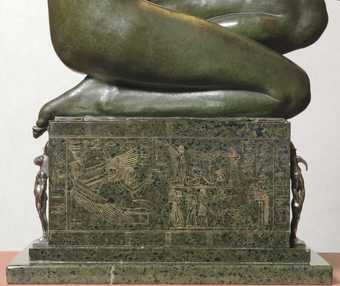
Fig.5
Edward Onslow Ford
Applause 1893 (detail)
Various visual and iconographic details of The Singer and Applause resonate in light of these imperial contexts. The taut neck and head of The Singer, for example, makes her appear as if she is standing to attention, like a loyal imperial subject (fig.2). This effect is further emphasised by the four caryatid figures on the bases of both The Singer and Applause, who stand with straight backs, heads upright, legs and feet together, and arms pressed firmly by their sides (figs.3 and 4).7 The economic and cultural importance of Egyptian cotton for Britain’s textile industry might also come to mind when looking at the thin, flowing gown of the lute player on the extreme right of the upper register of the side panels of Applause (fig.5).
In interpreting the statuette, however, it is important to note just how lucrative Britain’s Indian and African empires were for Ford, and how closely related London, Cairo, and Calcutta were in the British imperial imagination in the late nineteenth century. After all, interpretations of The Singer and Applause should not only be made in relation to the question of Britain’s specific imperial interest in Egypt and Sudan during the 1880s but also must consider the global breadth of the British Empire in the late nineteenth century. As Jasanoff has made clear, there is an unusually close relationship between the history of British imperial interests in Egypt and the history of British empire building in and around India throughout the nineteenth century. For example, Jasanoff documents how Egypt was of increasing importance to Britain following Napoleon’s invasion of Egypt in 1798, which challenged British dominance in the East by threatening to conquer rival territory more generally, and of bodies of land and water that were crucial stop-off points for Britons on their journeys to and from India.
The opening of the Suez Canal in 1869 shortened the journey time from Britain to India by two thirds.8 From a British imperialist perspective, therefore, India and Egypt were ‘combined into a single geopolitical vision, uniting national security with commerce and creating a union of peoples on the ground’.9 In addition, Jasanoff states that, just as each Egyptian antiquity collected was a ‘trophy of victory’ over time, the sun and sand, so, too, was it part of a larger, and longer power play between Britain, France, and Egypt itself over who had the ‘right and responsibility to possess and protect antiquities’.10
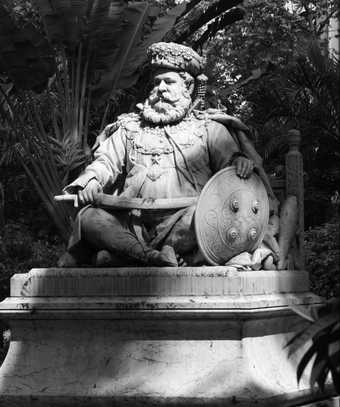
Fig.6
Edward Onslow Ford
Maharajah Lakshmeshwar Singh 1899 Dalhousie Square, Kolkata (Calcutta)
The British imperial connection between India and Egypt is noteworthy in the context of this discussion of The Singer and Applause, given how lucrative the Indian market was for Ford in the last two decades of the nineteenth century. Around 1890 Ford was commissioned by Lachmeswar Singh Bahadur, the Maharajah of Durbhanga, to produce two full-length allegorical figures of Dance and Music to occupy niches in his ballroom.11 Furthermore, between 1891 and 1895, while Ford was at work on Applause, he was also modelling an equestrian portrait of Hugh Rose, Baron Strathnairn, posing in his ‘Indian helmet with cascading feathers’, a statue ‘cast in gun-metal presented by the Indian government’.12 In 1898 Ford completed the commissioned, full-scale portrait of Sri Sri Chamarajah Waiyer, the Maharajah of Mysore, in full state costume, and in 1899, a seated portrait of Maharaja Lakshmeshwar Singh for Calcutta (fig.6).
Britain’s African empire was even more lucrative for Ford. As well as The Singer and Applause, Ford successfully marketed and sold statuette versions of the camel from his c.1887–9 General Gordon monument at the Arts and Crafts Exhibition in 1889. Ford was also commissioned by the Royal Engineers Corp to provide a commemorative silver shield for Gordon’s sisters, and was asked by the imperial hero Frederick Roberts to produce a silver equestrian statue of his son, who had died in the battle of Colenso during the Boer War, a conflict commemorated by Ford’s Glory to the Dead 1901.13 While these are as little remembered now as Applause and The Singer, Ford’s imperial work was much admired by his contemporaries. A.C.R. Carter commented, in 1898, that India had been the source of some of Ford’s most ‘important work’.14 And Walter Armstrong, referring to the quantity of work that went to India, publicly lamented that so many of Ford’s best statues ‘should be sent so far away’.15

Fig.7
Edward Onslow Ford
The Singer (detail)
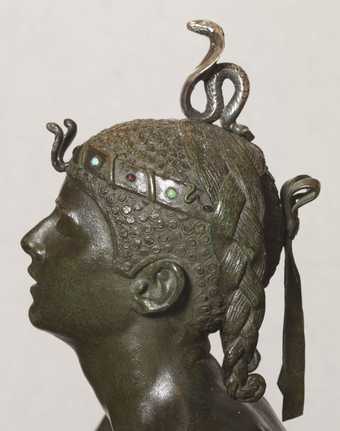
Fig.8
Edward Onslow Ford
Applause 1893 (detail)
Perhaps unsurprisingly in the context of fin-de-siècle imperialism, the racial profiles of Ford’s neo-Egyptian figures also interested contemporary commentators. For example, an anonymous visitor to Ford’s studio, writing in The Pall Mall Gazette in April 1889, suggested that the face of The Singer was of a ‘strong Egyptian type’.16 Compared to the comparatively flat-nosed and thick-lipped, white-marble Egyptian figures produced in the third quarter of the nineteenth century by Anglo-American sculptors such as William Theed, William Wetmore Story and Edmonia Lewis, or the more explicitly ethnographic approach of mid-century French sculptor Charles Henri Joseph Cordier, it is difficult to understand why Ford’s contemporaries thought the face of The Singer to be especially ‘Egyptian’.17 It should be noted, however, that in comparison to Story’s, Lewis’s and Theed’s mid-century, marble Cleopatra figures, whose heads tended to be covered in nemes, Ford’s Egyptian girls could have been viewed in racial terms because of their emphatically rendered hair (fig.7). The hair on The Singer has clear braiding, as does the figure in Applause (fig.8). In addition, given Queen Victoria’s widely reported purchase at the Great Exhibition of Cordier’s black bronze Said Abdallah, de la Tribue de Mayac, Royaume de Darfour 1848 and polychrome bronze African Venus 1852, both Ford’s polychromy and the addition of dark wax to the surface of The Singer, potentially align Ford’s neo-Egyptian works with Cordier’s earlier ethnographic project.18
